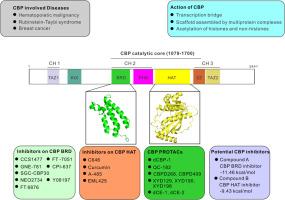CREB binding protein (CREBBP): Structure-based perspectives for the development of clinical inhibitors
IF 5
2区 医学
Q2 Medicine
引用次数: 0
Abstract
Acetylation is an essential process in biological processes. In tissues, protein acetylation occurs mainly at lysine (K) residues. The balance between acetylation and deacetylation is under the control of two enzyme families, histone acetyltransferase (HAT) and histone deacetylase (HDAC), respectively. Although there are many highly selective and potent HDAC inhibitors (such as romidepsin and belinostat), few HAT inhibitors are undergoing clinical trials. CREBBP, also known as CBP, is a member of the HAT family and plays a key role in several diseases, especially in hematopoietic malignancies, through the modulation of different signaling pathways. Studies have shown that CBP is highly expressed and activated in a variety of different tumors; therefore, its inhibitors have attracted increasing research attention. In this review, we discuss the importance of the structure of CBP in the development of potential inhibitors to provide a reference for the development of new selective CBP inhibitors.

CREB结合蛋白(CREBBP):基于结构的临床抑制剂开发前景
乙酰化是生物过程中的一个重要过程。在组织中,蛋白质乙酰化主要发生在赖氨酸(K)残基上。乙酰化和去乙酰化的平衡分别受组蛋白乙酰转移酶(histone acetyltransferase, HAT)和组蛋白去乙酰化酶(histone deacetylase, HDAC)两个酶家族控制。虽然有许多高选择性和有效的HDAC抑制剂(如罗米地辛和贝利诺他),但很少有HAT抑制剂正在进行临床试验。CREBBP,也被称为CBP,是HAT家族的一员,通过调节不同的信号通路在多种疾病,特别是造血恶性肿瘤中发挥关键作用。研究表明,CBP在多种不同的肿瘤中高度表达和激活;因此,其抑制剂越来越受到研究的关注。本文综述了CBP结构在潜在抑制剂开发中的重要性,为开发新的选择性CBP抑制剂提供参考。
本文章由计算机程序翻译,如有差异,请以英文原文为准。
求助全文
约1分钟内获得全文
求助全文
来源期刊

Translational Oncology
ONCOLOGY-
CiteScore
8.40
自引率
2.00%
发文量
314
审稿时长
54 days
期刊介绍:
Translational Oncology publishes the results of novel research investigations which bridge the laboratory and clinical settings including risk assessment, cellular and molecular characterization, prevention, detection, diagnosis and treatment of human cancers with the overall goal of improving the clinical care of oncology patients. Translational Oncology will publish laboratory studies of novel therapeutic interventions as well as clinical trials which evaluate new treatment paradigms for cancer. Peer reviewed manuscript types include Original Reports, Reviews and Editorials.
 求助内容:
求助内容: 应助结果提醒方式:
应助结果提醒方式:


